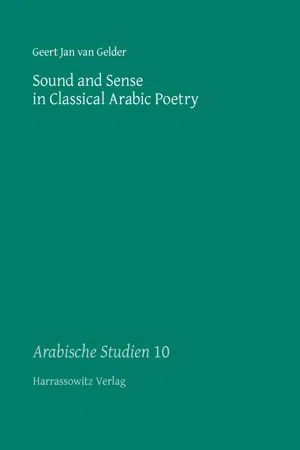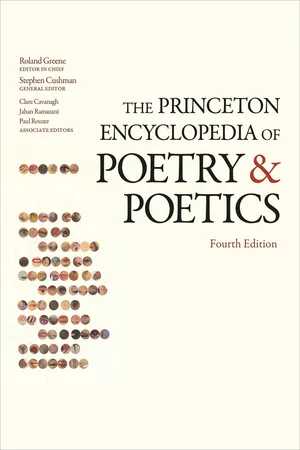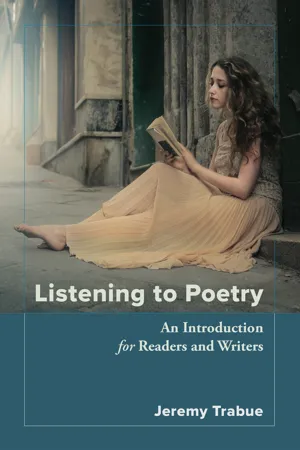Languages & Linguistics
Monorhyme
Monorhyme is a poetic form characterized by having all the lines in a poem end with the same rhyme. This creates a strong sense of unity and rhythm within the poem. Monorhyme is often used in Arabic and Persian poetry, as well as in modern English poetry, to create a sense of cohesion and emphasis on the repeated rhyme.
Written by Perlego with AI-assistance
Related key terms
1 of 5
3 Key excerpts on "Monorhyme"
- eBook - PDF
- Geert Jan van Gelder(Author)
- 2015(Publication Date)
- Harrassowitz Verlag(Publisher)
KG, Wiesbaden 5. Monorhyme and Monotony 193 As for the alleged monotony of Monorhyme, it is true that there is some-thing almost hypnotic or mesmerising in the repetition of rhymes in long po-ems, such as the 89 lines ending in -āmuhā of Labīd’s Muuni02BFallaqah , or the 337 lines ending in -ālī of a poem by Ibn al-Rūmī. 102 Much longer still is the Tāuni02BEiy-yah , mentioned above, by Ibn al-Fāriuni1E0D, with its 761 lines rhyming on -tī , and even this pales in comparison to the didactic poem by the theologian Ibn Qay-yim al-Jawziyyah (d. 751/1350), almost ironically entitled al-Kāfiyah al-shāfiyah fī l-intiuni1E63ār li-l-firqah al-nājiyah (“The Sufficient and Adequate [Poem] in Vindica-tion of the Saved Sect”), a poem in kāmil metre rhyming in -ānī , and said to have a staggering 5,828 lines. 103 It is true, too, that to those unaccustomed to Arabic verse a poem may, at first sight or hearing, appear shapeless with its every line having the same metrical structure (only relieved on a small scale by the ziuni1E25āfāt , the freedom of certain metrical slots) and the same rhyme. It may seem to resemble the repetition of identical elements so popular in the visual patterns of Arab or Islamic decorative art; or perhaps it could be deemed, rather, to contradict the concern of Arabic literary critics and visual artists for patterns, because strict Monorhyme amounts to the absence of a pattern, in terms of rhyme. Poets and critics like to compare poetic texture to patterned textiles, as is evident from the many comparisons of poems with “striped Yemeni cloth” or from the numerous technical terms for stylistic fea-tures derived from embroidery and weaving. Formal patterning plays a major part within the individual line, rather than the poem as a whole, and while Monorhyme is a feature of the whole poem, its effect is paradoxically far more clearly felt in the single line than in the complete product. - eBook - ePub
The Princeton Encyclopedia of Poetry and Poetics
Fourth Edition
- Stephen Cushman, Clare Cavanagh, Jahan Ramazani, Paul Rouzer, Stephen Cushman, Clare Cavanagh, Jahan Ramazani, Paul Rouzer(Authors)
- 2012(Publication Date)
- Princeton University Press(Publisher)
cywydd couplets, one of the rhymes must be a monosyllable but the other a polysyllable. But if rhyme depends for its distinctive effects on the morphology of the particular words involved in the rhyme, it also, therefore, depends on the morphological structure of the lang. itself as the ground against which the pattern becomes visible.Inflectional endings are, as it were, the antithesis or reflex of rhyme, though it is not accurate to say, as did Whitehall, that langs. in which like endings result automatically from inflection will never use rhyme as a structural device in verse. Rhyme is occasionally to be found, consciously used, in the lit. of the cl. langs. The notion of like endings (Gr. homoeoteleuton , Lat. similiter desinens ) is discussed by the ancients—Aristotle (Rhetoric 3.9.9–11), Dionysius of Halicarnassus (23), and Quintilian (9.3.77)—under the rubric of “verbal resemblance” or sound correspondence between clauses (paromoeosis ). Late antique *rhyme-prose continues this trad.; the *grammatical rhyme of the Grands Rhétoriqu eurs (see RHÉTORIQUEURS, GRANDS ) takes a different slant. But the two systems—case endings and rhyme—overwrite the same space and so in the main are mutually exclusive. And when, in any lang., rhyming is relatively easy, poets will tend to complicate it by employing forms of *rich or *identical rhyme (as in Fr.) or complex stanza forms (as in Occitan and Fr.) or both, or else by eschewing rhyme completely (as in *blank verse). Poets who choose to rhyme, in fact, walk a tightrope between ease and difficulty: too easy rhyming or too difficult rhyming eventually produce the same result—the poetic disuse of rhyme. In some verse systems, the rules in a prosody survive sometimes for centuries after the ling. facts on which they were originally based have disappeared. One of the chief instances of this process is the mute e - Available until 18 Jan |Learn more
Listening to Poetry
An Introduction for Readers and Writers
- Jeremy Trabue(Author)
- 2019(Publication Date)
- Chemeketa Press(Publisher)
At the other extreme, there are also many people who think of nonrhyming poetry as “modern” and rhyming poetry as “traditional.” This is also inaccurate. Old English poetry did not rhyme at all, nor did much poetry in Middle English. Unrhymed verse has been part of modern English right from the beginning. Seventeenth-century poet John Milton wrote a blistering attack on rhyme in his introduction to Paradise Lost (which does not rhyme). And most early English dramatic verse is mostly written without any rhyme (though some short rhyming passages do appear in Shakespeare and other renaissance drama).The role and importance of rhyme in poetry was much debated and contested in Milton’s time, and it still is today. Unrhymed poetry is more common, but rhyming poetry is alive and well. Rhyme is not omnipotent or omnipresent. Rhyme does not define “poem.” However, it is a part of poetry, and it’s here to stay.Rhyme is one of those subjects for which the phrase “deceptively simple” was created. Most preschoolers recognize and can give examples of rhyming words. Most could easily recognize the rhymes in this list:bed / embed / said / read bay / weigh / astray / they wing / asking / unifying / testifying lady / bee / abbey / tabbyBut what exactly makes these words “rhyming”? The entire ending syllable is not exactly the same in each one because the ending syllables may start with different consonant sounds. The spelling is certainly not the same in each one. However, the ending syllable after its initial con sonant sound is the same. Notice that they don’t have to have the same number of syllables, either, as long as that final syllable sound after its initial consonant is identical.Rhyme is the repetition of the same vowel sound followed by the same consonant sound—if there is one—in the final syllable of two or more words and in close enough proximity that it creates an obvious pattern. That’s the basic definition, but there is a lot of variation just under the surface of that definition that you should be aware of.Varieties of Rhyme
Rhyme is such a rich subject that there are different varieties of rhyme.First, rhymes can be either internal or end. End rhyme occurs at the ends of lines, and is the most common.When people talk about rhyme, they usually mean end rhyme. Internal rhyme,
Index pages curate the most relevant extracts from our library of academic textbooks. They’ve been created using an in-house natural language model (NLM), each adding context and meaning to key research topics.


